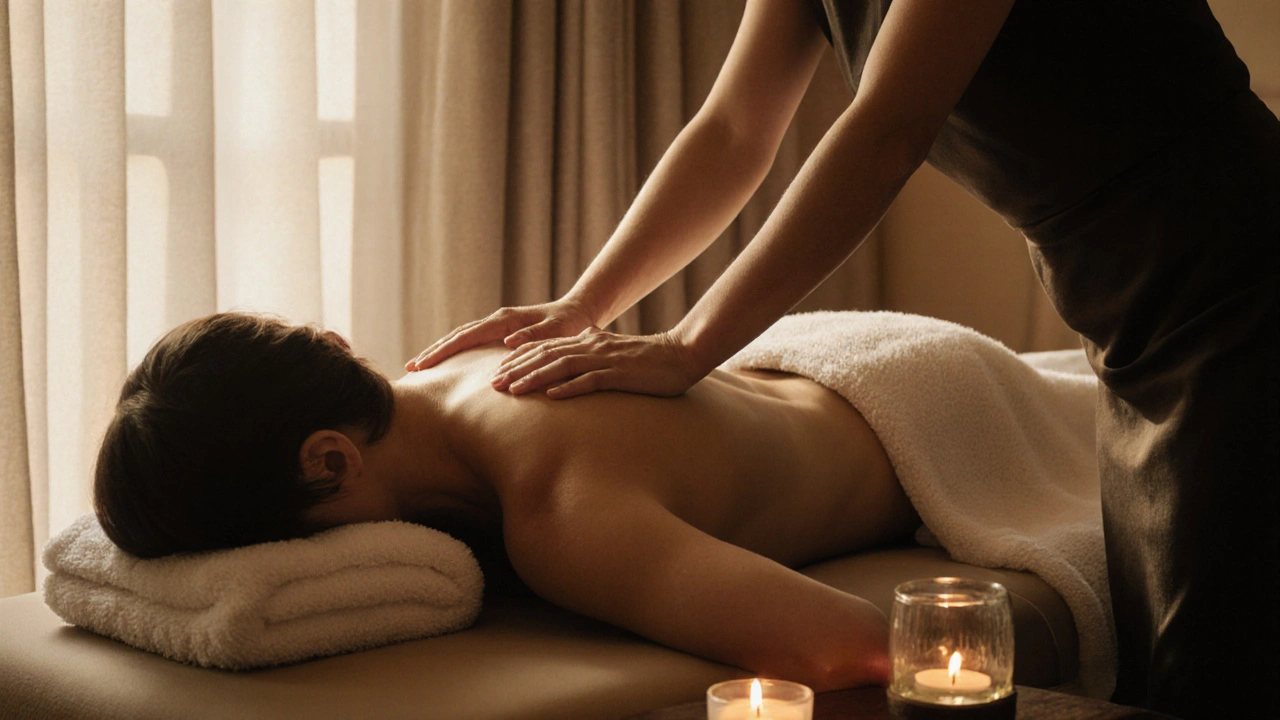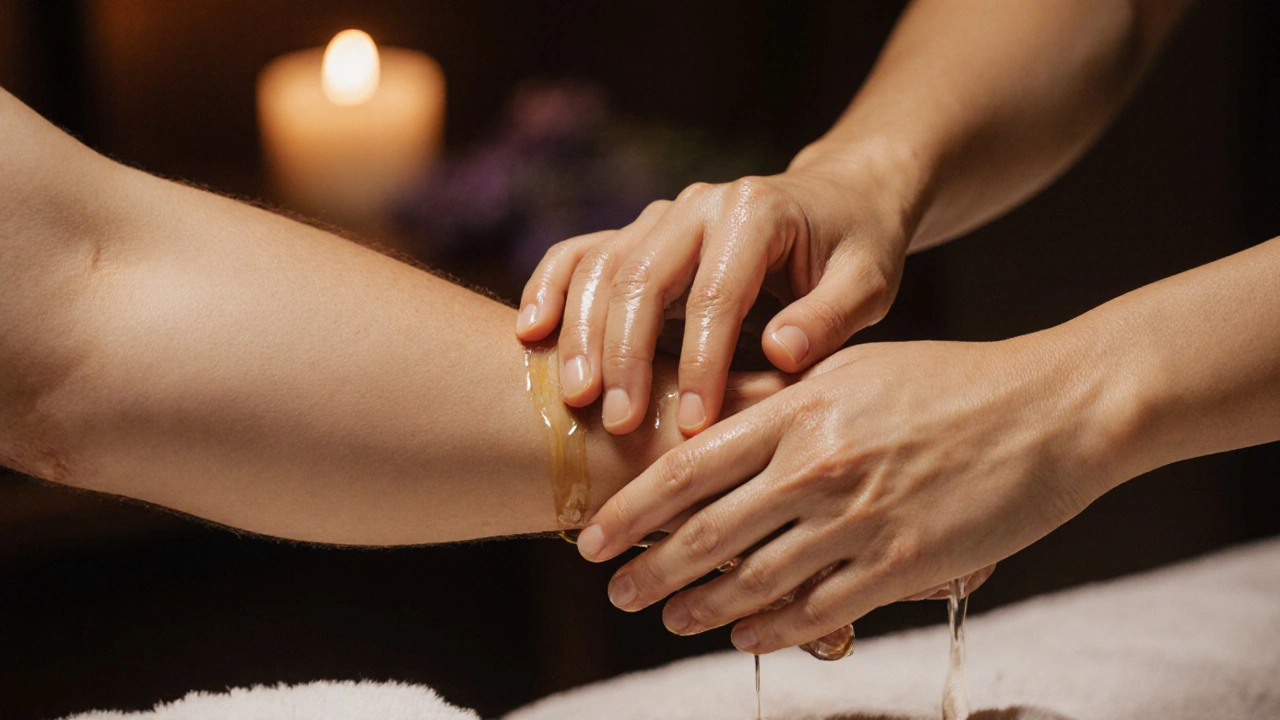Swedish Massage: The Simple, Science-Backed Way to Reduce Stress and Pain

You’ve probably heard of Swedish massage-but do you actually know what happens during one? It’s not just a fancy spa treat. It’s a proven method to melt away tension, ease chronic pain, and reset your nervous system. No needles. No sweat. Just hands, oil, and a room that smells like lavender. And yes, it works.
What Exactly Is Swedish Massage?
Swedish massage is the most common type of massage therapy in the world. It’s not mysterious. It’s not intense. It’s not supposed to hurt. Think of it as your body’s reset button. Developed in the 18th century by a Swedish physiologist named Per Henrik Ling, it uses five basic strokes: effleurage (long gliding movements), petrissage (kneading), friction (deep circular pressure), tapotement (rhythmic tapping), and vibration.
These aren’t random motions. Each one has a purpose. Effleurage warms up your muscles and improves circulation. Petrissage helps break up knots. Friction targets deeper layers without causing pain. Tapotement wakes up sleepy nerves. And vibration? That’s the gentle shake that makes you sigh without even realizing it.
Unlike deep tissue or sports massage, Swedish massage doesn’t aim to fix injuries. It’s for people who feel heavy-mentally, physically, emotionally. You’re not here to be torn apart. You’re here to be put back together, gently.
Why It Works: The Science Behind the Relaxation
Let’s cut through the spa buzz. Swedish massage isn’t magic. It’s biology.
A 2023 study from the Journal of Clinical Medicine tracked 120 adults who received weekly Swedish massages for six weeks. Those who got the massage reported a 41% drop in cortisol-the main stress hormone. Their heart rates slowed. Their blood pressure dropped. And their sleep quality improved by nearly 30%.
How? The pressure from the hands triggers your parasympathetic nervous system-the part of your body that says, “It’s safe to relax now.” Your muscles stop clenching. Your breathing deepens. Your brain stops replaying that awkward meeting from Tuesday.
It also boosts serotonin and dopamine. Those are your feel-good chemicals. No pills. No caffeine. Just touch.
What You’ll Actually Feel During a Session
Picture this: You walk into a quiet room. Soft music. Candles. The scent of almond oil. You lie face down on a warm table, covered with a towel. The therapist leaves the room to give you privacy.
When they return, their hands are warm. They start with your back-long, slow strokes from your neck down to your lower back. No sudden moves. No pressure that makes you wince. It’s like being hugged by a gentle wave.
Then they move to your legs. Kneading your calves, gliding over your thighs. You might feel a tiny tug where a muscle’s been tight for months. But it doesn’t hurt. It feels like relief.
When they flip you over, you notice how your shoulders drop. Your jaw unclenches. You didn’t even know you were holding your breath.
The whole thing lasts 60 to 90 minutes. No talking. No phone. Just you, the oil, and the rhythm of their hands.
Who Benefits Most From Swedish Massage?
You don’t need to be stressed out or in pain to benefit. But if you’re one of these people, you’ll feel it right away:
- You sit at a desk all day and your shoulders feel like concrete
- You lie awake at night thinking about tomorrow’s to-do list
- You’ve been feeling “off” for weeks-tired, irritable, flat
- You get headaches after long workdays
- You’re recovering from an injury but can’t handle deep pressure
It’s also great for older adults. A 2024 study in the Journal of Geriatric Physical Therapy found that seniors who got weekly Swedish massages improved their mobility and reduced joint stiffness faster than those who didn’t.
And if you’re new to massage? This is the one to start with. No pain. No surprises. Just calm.

What to Expect After Your First Session
Right after? You’ll feel light. Like you just woke up from a nap that lasted three hours. Your limbs might feel a little loose. Your mind? Quiet.
Some people feel a bit tired. That’s normal. Your body’s been in fight-or-flight mode for too long. Now it’s finally allowed to rest.
Drink water. Don’t jump into a workout or a stressful call. Give yourself a few hours to float. The real benefits-better sleep, less anxiety, reduced muscle soreness-show up over the next 24 to 48 hours.
One client told me: “I didn’t realize how much tension I carried until I didn’t have it anymore.”
Swedish Massage vs. Deep Tissue Massage
| Feature | Swedish Massage | Deep Tissue Massage |
|---|---|---|
| Pressure Level | Light to medium | Heavy, focused |
| Goal | Relaxation, circulation, stress relief | Break down chronic muscle knots, treat injuries |
| Pain Level | Minimal to none | Can be uncomfortable or painful |
| Best For | Stress, anxiety, sleep issues, general tension | Chronic pain, sports injuries, postural problems |
| Session Length | 60-90 minutes | 60-75 minutes |
| After Effects | Relaxed, calm, energized | Soreness for 1-2 days, then improved mobility |
If you’re not sure which one you need, start with Swedish. You can always move to deep tissue later-if you need it.
How to Find a Good Swedish Massage Therapist
Not all massage therapists are the same. Here’s how to find someone who actually knows what they’re doing:
- Look for licensed professionals. Check state or national certification boards (like NCBTMB in the U.S.).
- Read reviews that mention “gentle,” “calm,” or “didn’t hurt.” Avoid places with reviews saying “it was brutal” or “they didn’t ask about pain.”
- Ask if they specialize in relaxation or wellness massage. Swedish massage is often listed under “relaxation,” “classic,” or “full body.”
- Book a 60-minute first session. Don’t go straight for 90 minutes-you don’t know if you’ll like it yet.
- Trust your gut. If the room feels cold, the music is too loud, or they don’t ask about your goals, walk out.
Most reputable spas and wellness centers offer Swedish massage. You don’t need to hunt for a secret studio. Just pick one with clean sheets, quiet rooms, and therapists who listen.

How Much Does It Cost?
Prices vary by location, but here’s what you’ll typically pay in 2025:
- 60 minutes: $70-$110
- 90 minutes: $100-$150
- 120 minutes: $140-$200
Spas in big cities cost more. Independent therapists in quiet neighborhoods often charge less. Some clinics offer package deals-buy 5 sessions, get 1 free. That’s where the real savings kick in.
Insurance rarely covers it. But if you have an HSA or FSA account? You can often use those funds. Ask your provider.
What to Do Before and After
Small habits make a big difference.
Before: Don’t eat a heavy meal 2 hours before. Avoid caffeine-it can make you jittery instead of relaxed. Drink water. Show up 10 minutes early so you’re not rushing.
After: Drink at least two glasses of water. This helps flush out metabolic waste released during the massage. Skip intense exercise. Give yourself time to sit quietly. Maybe take a warm bath. Don’t rush back into your day.
If you feel sore the next day (rare with Swedish), a warm shower and light stretching will help.
Frequently Asked Questions
Is Swedish massage good for anxiety?
Yes. Multiple studies show that regular Swedish massage reduces cortisol levels and increases serotonin. It’s one of the most effective non-medical ways to calm an anxious nervous system. People with generalized anxiety disorder often report better sleep and fewer panic attacks after just 4-6 weekly sessions.
Can I get a Swedish massage if I’m pregnant?
Absolutely-but only with a therapist trained in prenatal massage. They’ll use special pillows and avoid certain pressure points. Many pregnant women say it’s the only thing that helps them sleep through the third trimester.
How often should I get a Swedish massage?
For stress relief, once a month is enough. If you’re dealing with chronic tension, sleep issues, or high stress, aim for once every 2-3 weeks. Think of it like brushing your teeth-you don’t wait until your gums bleed to do it.
Do I need to be naked?
You’re covered with a towel the whole time. Only the part being worked on is exposed. Most people keep their underwear on. The therapist will leave the room while you get settled. Your comfort comes first-always.
Is Swedish massage just for women?
No. Men make up nearly 40% of regular massage clients. High-stress jobs, long commutes, and emotional burnout don’t care about gender. If you’re tired, tense, or just need to feel human again-you’re the exact person this massage was made for.
Ready to Feel Light Again?
You don’t need a vacation. You don’t need a miracle. You just need 60 minutes with warm hands and quiet space. Swedish massage isn’t a luxury. It’s a repair tool-for your body, your mind, your nervous system.
Book your first session. Don’t wait until you’re completely burnt out. Start now. Your future self will thank you.



Eugene Stanley
November 23, 2025 AT 00:02Just got my first Swedish massage last week-honestly, I didn’t think it’d do anything. I’m a ‘tough it out’ guy. But after 60 minutes? I cried. Not because it hurt. Because I finally felt safe enough to relax. My shoulders haven’t been this low since college. 🥹